Family Name: Anacardiaceae R. Brown
Synonym(s): Blepharocaryaceae Airy Shaw; Cassuviaceae Juss. ex R. Br., nom. illeg.; Julianiaceae Hemsl., nom. cons.; Pistaciaceae Martinov; Podoaceae Baill. ex Franch.; Spondiadaceae Martinov
Common Name(s): sumac family
*Number of genera/species: 83/860
List of genera records in GRIN-Global
Fruit a drupedrupe:
(indehiscent drupe) a fleshy, indehiscent fruit with one more hard pits enclosing seeds, derived from single, superior, simple or compound ovary; (dehiscent drupe) a fruit with a dry or fibrous to fleshy or leathery outer husk that early to tardily breaks apart (or opens), exposing one or more nutlike pits enclosing the seeds , samarasamara:
, samarasamara:
a winged, indehiscent, dry fruit containing a single (rarely two) seed(s) , or utricleutricle:
, or utricleutricle:
a small, indehiscent, dry fruit with a thin wall (bladderlike) that is loose and free from the seed, derived from a single, superior, simple ovary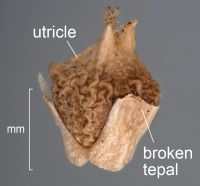 , 3–100 mm (to 250 mm, Mangifera), globoseglobose:
, 3–100 mm (to 250 mm, Mangifera), globoseglobose:
3D shape—more or less spherical to reniformreniform:
to reniformreniform:
2D or 3D shape—kidney-shaped , often laterally compressedcompressed:
, often laterally compressedcompressed:
flattened; in grasses, used to denote compression (not necessarily flattened) either laterally or dorsiventrally
, tereteterete:
approximately circular in cross section; width and thickness approximately equal
 or compressedcompressed:
or compressedcompressed:
flattened; in grasses, used to denote compression (not necessarily flattened) either laterally or dorsiventrally
in transection, rarely with a one apicalapical:
at or pertaining to the end of the seed or fruit distal from its point of attachment (i.e., base)
wing samarasamara:
a winged, indehiscent, dry fruit containing a single (rarely two) seed(s) ) Amphipterygium, Loxopterygium, Schinopsis), with 1–5(–12) seeds, sometimes enclosed by hypanthium. Pericarppericarp:
) Amphipterygium, Loxopterygium, Schinopsis), with 1–5(–12) seeds, sometimes enclosed by hypanthium. Pericarppericarp:
fruit wall or fruit coat
variously colored, shinyshiny:
uniformly reflecting a high proportion of incident light at all angles or dulldull:
or dulldull:
reflecting only a low proportion of incident light, with no apparent sheen , multilayered and well differentiated, fleshy or dry, glabrousglabrous:
, multilayered and well differentiated, fleshy or dry, glabrousglabrous:
without hairs
, pubescentpubescent:
surface relief—bearing hairs
, sometimes glandularglandular:
surface relief—covered with small, raised secretory glands, regular or irregularly shaped, translucent or opaque, and maybe distinctly colored or with bristles (Rhus spp.), smooth or sometimes striated, ribbedribbed:
or with bristles (Rhus spp.), smooth or sometimes striated, ribbedribbed:
surface relief—wide, prominent, linear ridges that are generally rounded and longitudinally situated on the surface , ridgedridged:
, ridgedridged:
surface relief—raised, thick ridges, sharp edged or rounded, usually in a series that may cover the entire surface , wrinkledwrinkled:
, wrinkledwrinkled:
surface relief—shallow, irregular folds and furrows covering the surface; appearing overall though crumpled and then spread out , or veinedveined:
, or veinedveined:
surface relief—lines that intersect in a vein pattern that is flush or slightly raised from the surface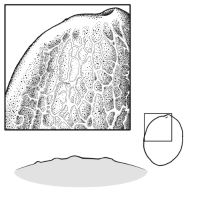 . In drupesdrupe:
. In drupesdrupe:
(indehiscent drupe) a fleshy, indehiscent fruit with one more hard pits enclosing seeds, derived from single, superior, simple or compound ovary; (dehiscent drupe) a fruit with a dry or fibrous to fleshy or leathery outer husk that early to tardily breaks apart (or opens), exposing one or more nutlike pits enclosing the seeds , mesocarpmesocarp:
, mesocarpmesocarp:
the middle layer of the pericarp, if divided into layers usually black, orange, red or white and fleshy, fibrousfibrous:
usually black, orange, red or white and fleshy, fibrousfibrous:
texture—long, flexible threads, thicker than hairs, that densely cover and obscure the surface , or resinous (waxy or oily), resin irritating. Endocarpendocarp:
, or resinous (waxy or oily), resin irritating. Endocarpendocarp:
the inner layer of the pericarp, if divided into layers woody, bonybony:
woody, bonybony:
very hard and rather brittle, like bone
, leatheryleathery:
texture—moderately thick, tough, and very pliable
, or fibrousfibrous:
texture—long, flexible threads, thicker than hairs, that densely cover and obscure the surface , often with operculaoperculum:
, often with operculaoperculum:
a dehiscent cap (or lid) of a seed or fruit that opens during germination or dehiscence (1–12).
(1–12).
In Anacardium and Semecarpus, drupesdrupe:
(indehiscent drupe) a fleshy, indehiscent fruit with one more hard pits enclosing seeds, derived from single, superior, simple or compound ovary; (dehiscent drupe) a fruit with a dry or fibrous to fleshy or leathery outer husk that early to tardily breaks apart (or opens), exposing one or more nutlike pits enclosing the seeds borne on enlarged fleshy pedicelspedicel:
borne on enlarged fleshy pedicelspedicel:
the stalk of a flower
and receptacles or hypocarps. In Dobinea, drupesdrupe:
(indehiscent drupe) a fleshy, indehiscent fruit with one more hard pits enclosing seeds, derived from single, superior, simple or compound ovary; (dehiscent drupe) a fruit with a dry or fibrous to fleshy or leathery outer husk that early to tardily breaks apart (or opens), exposing one or more nutlike pits enclosing the seeds fused to accrescentaccrescent:
fused to accrescentaccrescent:
growing continuously
floral bracts.
Seeds lens-shapedlens-shaped:
2D shape—round and flattened with two curved (convex) surfaces
to reniformreniform:
2D or 3D shape—kidney-shaped , 2–100 mm long, more or less with an enlarged chalazaechalaza:
, 2–100 mm long, more or less with an enlarged chalazaechalaza:
the region at the base of the ovule where the integuments are inserted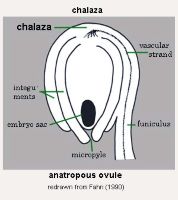 (pachychalazal). Seed coat green, brown, or orange, membranousmembranous:
(pachychalazal). Seed coat green, brown, or orange, membranousmembranous:
texture—extremely thin, pliable, and fairly tough
, smooth or ribbedribbed:
surface relief—wide, prominent, linear ridges that are generally rounded and longitudinally situated on the surface , ridgedridged:
, ridgedridged:
surface relief—raised, thick ridges, sharp edged or rounded, usually in a series that may cover the entire surface , wrinkledwrinkled:
, wrinkledwrinkled:
surface relief—shallow, irregular folds and furrows covering the surface; appearing overall though crumpled and then spread out , or ruminateruminate:
, or ruminateruminate:
testa or seed coat folded into the endosperm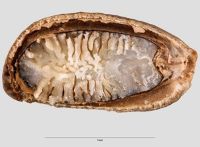 .
.
Embryo usually one per seed (sometimes more, Mangifera), well developed, partially filling seed cavity, axil and centric, foliatefoliate:
appearing leaf-like
, straight or curvedcurved:
(of embryo) linear embryo is curved into an arch or horseshoe with the ends far apart , and usually with fleshy, planoconvex or flat and distinct cotyledons.
, and usually with fleshy, planoconvex or flat and distinct cotyledons.
Endosperm absent or scanty, if present smooth or ruminateruminate:
testa or seed coat folded into the endosperm (Mangifera).
(Mangifera).
| Fruit | |
| Type | drupedrupe: (indehiscent drupe) a fleshy, indehiscent fruit with one more hard pits enclosing seeds, derived from single, superior, simple or compound ovary; (dehiscent drupe) a fruit with a dry or fibrous to fleshy or leathery outer husk that early to tardily breaks apart (or opens), exposing one or more nutlike pits enclosing the seeds  , samarasamara: , samarasamara:a winged, indehiscent, dry fruit containing a single (rarely two) seed(s)  , utricleutricle: , utricleutricle:a small, indehiscent, dry fruit with a thin wall (bladderlike) that is loose and free from the seed, derived from a single, superior, simple ovary  |
| Size range | 3–100 mm long, to 250 mm, Mangifera |
| Shape(s) | globoseglobose: 3D shape—more or less spherical  , discoiddiscoid: , discoiddiscoid:3D shape—resembling a disc 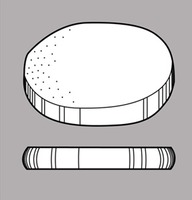 , lens-shapedlens-shaped: , lens-shapedlens-shaped:2D shape—round and flattened with two curved (convex) surfaces , ellipsoidellipsoid: 3D shape—elliptic , oblongoblong: 2D shape—much longer than broad with nearly parallel sides, corners are rounded  , ovoidovoid: , ovoidovoid:3D shape—ovate  , obovoidobovoid: , obovoidobovoid:3D shape—obovate , pyriform, falcatefalcate: shaped like a scythe or sickle  (samarasamara: (samarasamara:a winged, indehiscent, dry fruit containing a single (rarely two) seed(s)  ), reniformreniform: ), reniformreniform:2D or 3D shape—kidney-shaped  , often laterally compressedcompressed: , often laterally compressedcompressed:flattened; in grasses, used to denote compression (not necessarily flattened) either laterally or dorsiventrally |
| Texture | fleshy, dry |
| Surface relief | smooth, striated, ribbedribbed: surface relief—wide, prominent, linear ridges that are generally rounded and longitudinally situated on the surface  , ridgedridged: , ridgedridged:surface relief—raised, thick ridges, sharp edged or rounded, usually in a series that may cover the entire surface  , wrinkledwrinkled: , wrinkledwrinkled:surface relief—shallow, irregular folds and furrows covering the surface; appearing overall though crumpled and then spread out  , veinedveined: , veinedveined:surface relief—lines that intersect in a vein pattern that is flush or slightly raised from the surface  , bristlybristly: , bristlybristly:having bristles or stiff hair or hair-like structures 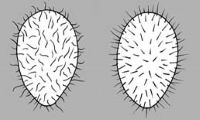 |
| Color(s) | black, gray, purple, blue, green, blue, brown, yellow, orange, red, white |
| Unique features | Drupaceous fruits, often with resinous mesocarpmesocarp: the middle layer of the pericarp, if divided into layers  , with a bonybony: , with a bonybony:very hard and rather brittle, like bone , woodywoody: texture—consisting mainly of indurate lignified tissues, characteristic of or resembling wood , or fibrousfibrous: texture—long, flexible threads, thicker than hairs, that densely cover and obscure the surface  endocarpendocarp: endocarpendocarp:the inner layer of the pericarp, if divided into layers  , often opening via one or more operculumoperculum: , often opening via one or more operculumoperculum:a dehiscent cap (or lid) of a seed or fruit that opens during germination or dehiscence  , and with a single seed. , and with a single seed. |
| Seed | |
| Size range | 2–100 mm long |
| Shape(s) | lens-shape, ellipsoidellipsoid: 3D shape—elliptic , ovoidovoid: 3D shape—ovate  , falcatefalcate: , falcatefalcate:shaped like a scythe or sickle  , reniformreniform: , reniformreniform:2D or 3D shape—kidney-shaped  , often compressedcompressed: , often compressedcompressed:flattened; in grasses, used to denote compression (not necessarily flattened) either laterally or dorsiventrally |
| Surface relief | smooth, ribbedribbed: surface relief—wide, prominent, linear ridges that are generally rounded and longitudinally situated on the surface  , ridgedridged: , ridgedridged:surface relief—raised, thick ridges, sharp edged or rounded, usually in a series that may cover the entire surface  , wrinkledwrinkled: , wrinkledwrinkled:surface relief—shallow, irregular folds and furrows covering the surface; appearing overall though crumpled and then spread out  |
| Color(s) | green, brown, orange |
| Unique features | Seeds usually with a large chalazalchalaza: the region at the base of the ovule where the integuments are inserted  and a well developed embryo, with fleshy, plano-convexplano-convex: and a well developed embryo, with fleshy, plano-convexplano-convex:2D or 3D shape—flat on one side, convex on the other 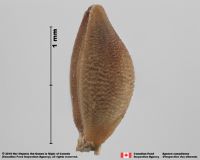 or flat and distinct cotyledons, and no or scanty endosperm. or flat and distinct cotyledons, and no or scanty endosperm. |
| Other | |
| Embryo | usually one per seed (sometimes more, Mangifera), well developed, partially filling seed cavity, axil and centric, foliatefoliate: appearing leaf-like , straight or curvedcurved: (of embryo) linear embryo is curved into an arch or horseshoe with the ends far apart  , and usually with planoconvex or flat and distinct cotyledons , and usually with planoconvex or flat and distinct cotyledons |
| Nutritive tissue | endosperm absent or trace, if present smooth or ruminateruminate: testa or seed coat folded into the endosperm  (Mangifera) (Mangifera) |
Worldwide, mainly tropical areas
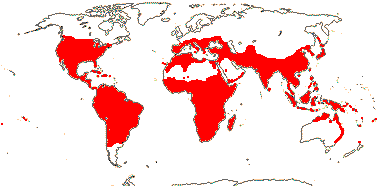
Distribution map courtesy of Angiosperm Phylogeny Website.
Bingham et al. 2021+Bingham et al. 2021+:
Bingham MG, Willeman A, Wursten BT, Ballings P, and Hyde MA. 2021. Flora of Zambia. Accessed January 2021–April 2024. URL: https://www.zambiaflora.com; Flora of Australia 2021+Flora of Australia 2021+:
Flora of Australia. Australian Biological Resources Study, Canberra. Accessed January 2021–March 2024. URL: http://www.ausflora.org.au; Hyde et al. 2021aHyde et al. 2021a:
Hyde MA, Wursten BT, Ballings P, and Coates Palgrave M. 2021a. Flora of Botswana. Accessed January–April 2024. URL: https://www.botswanaflora.com/index.php; Hyde et al. 2023Hyde et al. 2023:
Hyde MA, Wursten BT, Ballings P, and Coates Palgrave M. 2023. Flora of Malawi. Accessed January–December 2023. URL: https://www.malawiflora.com/index.php; Kirkbride et al. 2006Kirkbride et al. 2006:
Kirkbride JH, Jr, Gunn CR, and Dallwitz MJ. 2006. Family guide for fruits and seeds, vers. 1.0. Accessed September 2020-January 2022. URL: https://nt.ars-grin.gov/seedsfruits/keys/frsdfam/index.cfm .; Kubitzki et al. 1990+Kubitzki et al. 1990+:
Kubitzki K et al., eds. 1990+. The families and genera of vascular plants. 7+ vols. Berlin etc.; Nooteboom et al. 2021+Nooteboom et al. 2021+:
Nooteboom HP, de Wilde WJJO, Stevens PF, Coode MJE, and Saw LG. 2021+ Flora Malesiana Online. Accessed January 2021–March 2024. URL: https://portal.cybertaxonomy.org/flora-malesiana/; Takhtajan 2009Takhtajan 2009:
Takhtajan A. 2009. Flowering plants: Second edition. Springer Nature, Switzerland. 871 pp.; Zhengyi et al. 2004+Zhengyi et al. 2004+:
Zhengyi W, Raven PH, and Deyuan H. 2004+. Flora of China [online]. 25 vols. Science Press, Beijing China & Missouri Botanical Garden, St. Louis USA. Accessed January–March 2024. http://flora.huh.harvard.edu/china/
*The number of genera and species is based on Christenhusz and Byng 2016Christenhusz and Byng 2016:
Christenhusz MJM and Byng JW. 2016. The number of known plant species in the world and its annual increase. Phytotaxa 261 (3): 201-217. https://doi.org/10.11646/phytotaxa.261.3.1, which may differ from the number of genera in GRIN-Global.